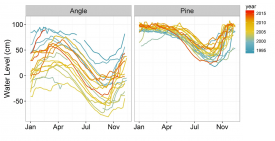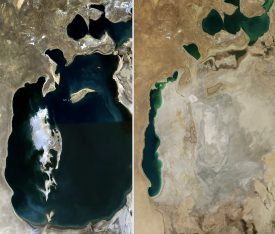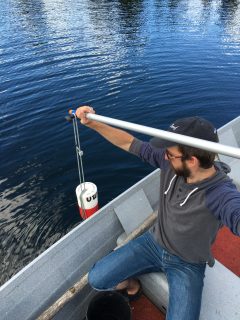By Vincent Jobin, PhD candidate, School of Aquatic and Fishery Sciences, University of Washington
Freshwater resources are facing increasing pressure from many sources. We withdraw water for human consumption and agriculture. Increasing temperatures due to climate change lead to more evaporation. These intense pressures can be illustrated by dramatic examples like the Aral Sea in Central Asia, pictured below. Once the fourth-largest lake in the world, it has been reduced to a fraction of its former size (Figure 1) since its two main tributaries were diverted for irrigation projects in the 1960’s.
This had disastrous consequences for the organisms living in the lake as well as the human populations living around the lake.
In less dramatic fashion, changes in water level do occur naturally in lakes due to seasonal changes in precipitation and evaporation. In the Pacific Northwest, most lakes follow a clear seasonal pattern with higher water levels during the cool and wet winter and lower levels in the dry, warmer summers (Figure 2). But all lakes do not behave the same. Some experience larger annual fluctuations than others. Some have a stable pattern each year and others do not. Such variations can be driven by climactic differences, lake morphology or watershed parameters and their interaction. Deviations from natural fluctuations are occurring due to human water use and climatic extremes such as droughts and floods, which are predicted to intensify with climate change. There is growing evidence that these deviations impact the abundance of aquatic plants, macroinvertebrates and fish in the lakes.

Figure 2. Relative water level (cm) in Angle and Pine Lakes, two lakes in King County’s Lake Stewardship Program.
Although much work has been done in reservoirs, there is relatively less information about water level fluctuations in lakes. With our project, we want to fill that gap and elucidate the patterns, drivers and ecological implications of water level fluctuations in lakes of the Puget Sound Lowlands.
To do this, we will use data from many sources. We already have data from Snohomish County’s Surface Water Management, Pierce County’s Conservation District and King County’s Lake Stewardship Monitoring program. In King County, volunteers monitor water level daily in several lakes. They also monitor temperature, Secchi depth, phosphorus and nitrogen levels, and other parameters. As many as 60 lakes in King County are or have been monitored since the beginning of the program in 1993. To this incredible dataset, we will add data from our own sampling. We already deployed temperature loggers in 15 lakes to investigate the relationship between water levels and thermal regimes (Figure 3). The Nancy Weller Memorial Scholarship provided by WALPA will help me finance the equipment needed for my PhD research on this topic in the School of Aquatic and Fishery Sciences at the University of Washington.
To stay updated on the project, consult our website (http://lakelevels.weebly.com/). We will update it regularly with news from the project, results from our investigation, and plenty of pictures from the beautiful lakes in the region.











